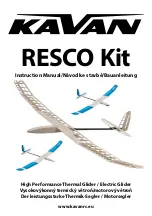
8
Section 1
Introduction
01 Introduction
10 Safety Rules
1. The greatest risk with “Hybrids” is
their simplicity
This can cause users to be tempted into
forgetting or ignoring risks.
Exercise particular care if it starts to feel too
“normal”.
2. Assess objective risks
WEATHER: Never fly if there is a
föhn
wind,
storm or cold front. Your Hybrid Sport offers
maximum safety, but the risks caused by
extreme turbulence are unpredictable.
AVALANCHE:
Only go into unstable areas if
you have the appropriate skills/training and
equipment (avalanche transceiver, snow
shovel etc).
3. Inspect your equipment
Inspect your equipment thoroughly prior to
each launch, and do not launch if you
discover
any
damage.
Adjust
your
equipment according to the conditions. We
recommend that you always have a reserve
chute.
4. Assess your own well-being
Never fly if you are unwell,
whether
you are
physically unwell or have other concerns.
Take a rest day - the mountains will always
be there.
5. WHAT IF? - Plan B
Do not make any impulsive decisions. Take
time to analyse the situation. Always make a
plan B (e.g. choice of route, emergency
landing areas etc).
6. ALWAYS CARRY OUT A SAFETY-RUN
Reconnoitre a new route by making a flight
with sufficient height. Be on the look-out for
potential obstacles. Ensure when flying near
ground level that no third parties will be
injured.
7. Twice the speed = four times the
energy
Remember that small mistakes can quickly
have fatal consequences.
8. Do not be afraid to speak out
if you feel that others are overestimating
their abilities. Likewise, accept comments
from others,
even if it is
unpleasant to
acknowledge mistakes.
9. ANALYSE YOUR MISTAKES
Analyse any close-calls as if they had been
actual accidents and learn the necessary
lessons. Avoid a repetition, because next
time it could be too late.
10. NO RISK – NO FUN, NO LIMIT – NO
LIFE
Respect your limits and do not go beyond
them just because you are with experienced
pilots. Have the courage to say “enough”!









































